8051 Microcontroller: Simulators, Emulators, Benefits & Challenges
VerifiedAdded on 2023/06/12
|9
|1386
|392
Report
AI Summary
This report provides an overview of microcontroller simulation, focusing on the 8051 microcontroller. It identifies and describes several simulators, including EdSim51, MCU 8051, and 8051 IDE, outlining their main characteristics and providing web links. The report further discusses the benefits of simulating microcontroller board applications, such as enabling practical responses in real-world system design and facilitating a deeper understanding of system behavior. It also addresses the challenges of simulation, including human behavior complexities, costs, and time consumption. The report concludes with a bibliography of cited sources.

Microcontroller Programming and Interfacing In computer since 1
MICROCONTROLLER PROGRAMMING AND INTERFACING IN COMPUTER SINCE
By Name
Course
Instructor
Institution
Location
Date
MICROCONTROLLER PROGRAMMING AND INTERFACING IN COMPUTER SINCE
By Name
Course
Instructor
Institution
Location
Date
Paraphrase This Document
Need a fresh take? Get an instant paraphrase of this document with our AI Paraphraser
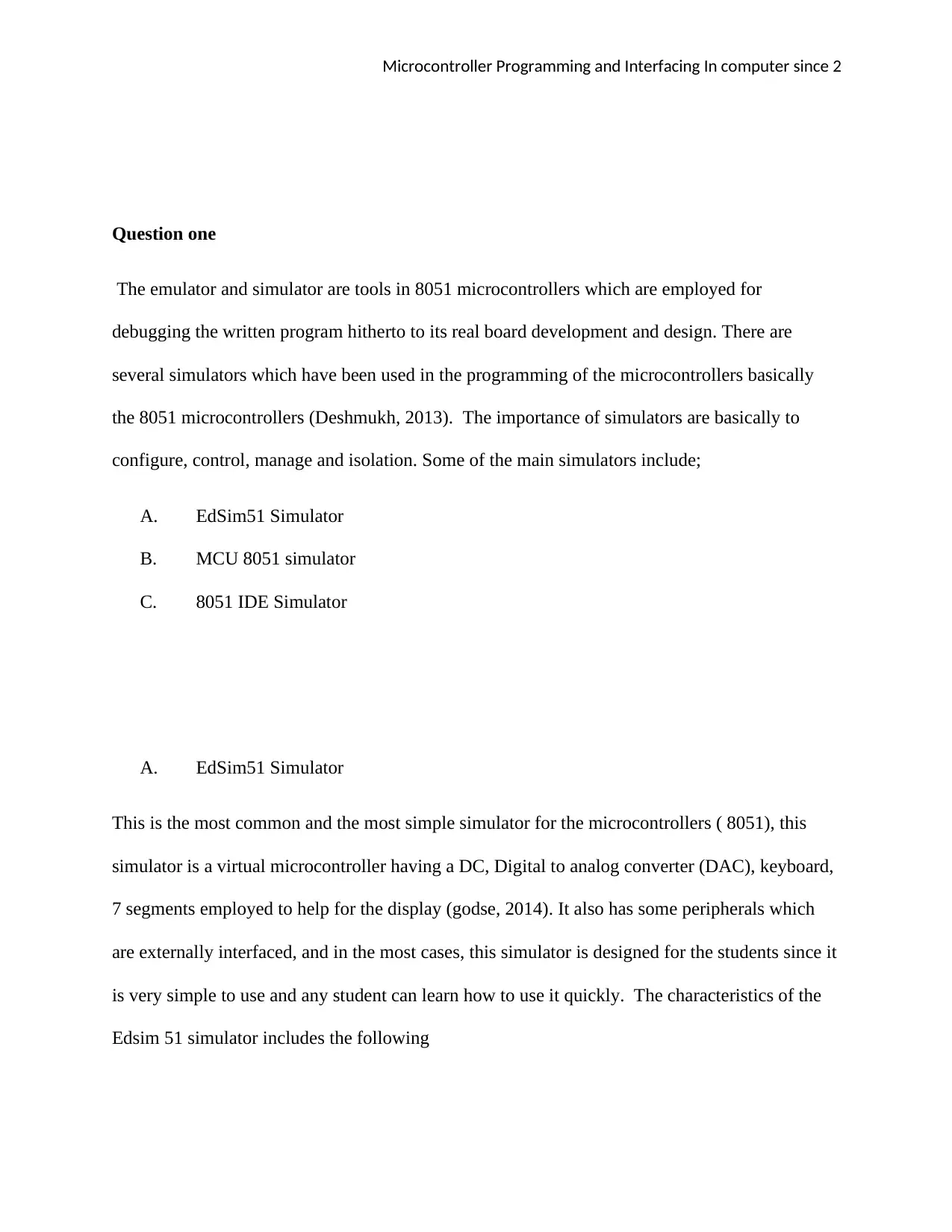
Microcontroller Programming and Interfacing In computer since 2
Question one
The emulator and simulator are tools in 8051 microcontrollers which are employed for
debugging the written program hitherto to its real board development and design. There are
several simulators which have been used in the programming of the microcontrollers basically
the 8051 microcontrollers (Deshmukh, 2013). The importance of simulators are basically to
configure, control, manage and isolation. Some of the main simulators include;
A. EdSim51 Simulator
B. MCU 8051 simulator
C. 8051 IDE Simulator
A. EdSim51 Simulator
This is the most common and the most simple simulator for the microcontrollers ( 8051), this
simulator is a virtual microcontroller having a DC, Digital to analog converter (DAC), keyboard,
7 segments employed to help for the display (godse, 2014). It also has some peripherals which
are externally interfaced, and in the most cases, this simulator is designed for the students since it
is very simple to use and any student can learn how to use it quickly. The characteristics of the
Edsim 51 simulator includes the following
Question one
The emulator and simulator are tools in 8051 microcontrollers which are employed for
debugging the written program hitherto to its real board development and design. There are
several simulators which have been used in the programming of the microcontrollers basically
the 8051 microcontrollers (Deshmukh, 2013). The importance of simulators are basically to
configure, control, manage and isolation. Some of the main simulators include;
A. EdSim51 Simulator
B. MCU 8051 simulator
C. 8051 IDE Simulator
A. EdSim51 Simulator
This is the most common and the most simple simulator for the microcontrollers ( 8051), this
simulator is a virtual microcontroller having a DC, Digital to analog converter (DAC), keyboard,
7 segments employed to help for the display (godse, 2014). It also has some peripherals which
are externally interfaced, and in the most cases, this simulator is designed for the students since it
is very simple to use and any student can learn how to use it quickly. The characteristics of the
Edsim 51 simulator includes the following
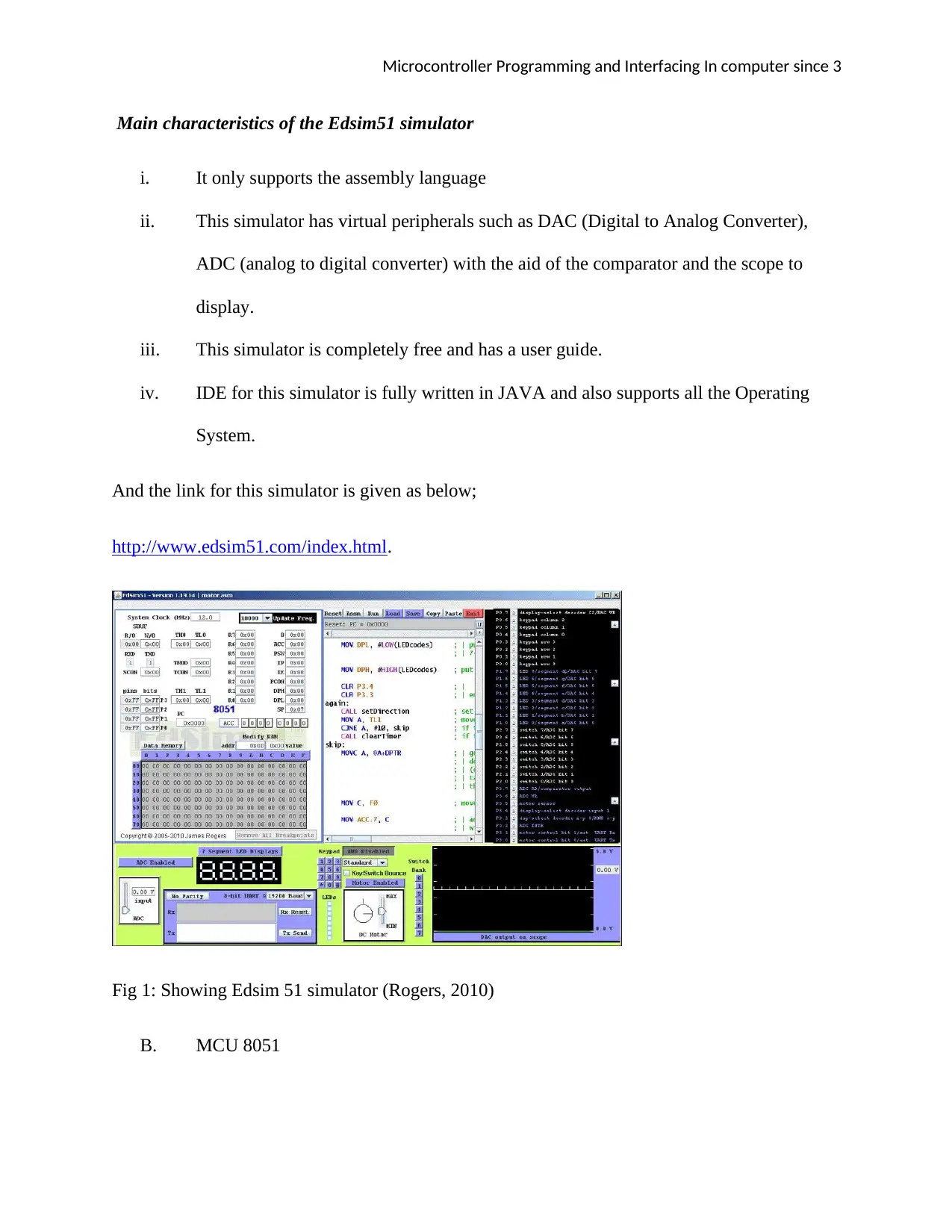
Microcontroller Programming and Interfacing In computer since 3
Main characteristics of the Edsim51 simulator
i. It only supports the assembly language
ii. This simulator has virtual peripherals such as DAC (Digital to Analog Converter),
ADC (analog to digital converter) with the aid of the comparator and the scope to
display.
iii. This simulator is completely free and has a user guide.
iv. IDE for this simulator is fully written in JAVA and also supports all the Operating
System.
And the link for this simulator is given as below;
http://www.edsim51.com/index.html.
Fig 1: Showing Edsim 51 simulator (Rogers, 2010)
B. MCU 8051
Main characteristics of the Edsim51 simulator
i. It only supports the assembly language
ii. This simulator has virtual peripherals such as DAC (Digital to Analog Converter),
ADC (analog to digital converter) with the aid of the comparator and the scope to
display.
iii. This simulator is completely free and has a user guide.
iv. IDE for this simulator is fully written in JAVA and also supports all the Operating
System.
And the link for this simulator is given as below;
http://www.edsim51.com/index.html.
Fig 1: Showing Edsim 51 simulator (Rogers, 2010)
B. MCU 8051
⊘ This is a preview!⊘
Do you want full access?
Subscribe today to unlock all pages.

Trusted by 1+ million students worldwide

Microcontroller Programming and Interfacing In computer since 4
This is an 8051 simulator that is so simple to use and it also has an iterative integrated
Development Environment (IDE). Basically, this simulator was designed by Osmera Martin and
he made this simulator free for use (Rogers, 2010). The below are some of the characteristics of
the MCU 8051.
Main characteristics of the MCU 8051
i. MCU 8051 has inbuilt code editor source, ASCII chart, graphical note, and assembly
symbol. It as well supports several 8051 ICs such as A89S52, 89C51
ii. This simulator can support both assembly language and C language simulation and
compilation.
iii. This simulator also supports syntax validation and pop base auto-completion.
iv. The simulator contains tools such as a base converter, special calculator, inbuilt
programmer, hex decimal editor and file converter.
v. MCU 80511 will as well supports some electronic simulations like LCD display,
LED and seven segment display that will aid in giving the output if one interface
these to the hardware directly.
And the link for this simulator is given as below;
http://sourceforge.net/projects/mcu8051ide/files/
This is an 8051 simulator that is so simple to use and it also has an iterative integrated
Development Environment (IDE). Basically, this simulator was designed by Osmera Martin and
he made this simulator free for use (Rogers, 2010). The below are some of the characteristics of
the MCU 8051.
Main characteristics of the MCU 8051
i. MCU 8051 has inbuilt code editor source, ASCII chart, graphical note, and assembly
symbol. It as well supports several 8051 ICs such as A89S52, 89C51
ii. This simulator can support both assembly language and C language simulation and
compilation.
iii. This simulator also supports syntax validation and pop base auto-completion.
iv. The simulator contains tools such as a base converter, special calculator, inbuilt
programmer, hex decimal editor and file converter.
v. MCU 80511 will as well supports some electronic simulations like LCD display,
LED and seven segment display that will aid in giving the output if one interface
these to the hardware directly.
And the link for this simulator is given as below;
http://sourceforge.net/projects/mcu8051ide/files/
Paraphrase This Document
Need a fresh take? Get an instant paraphrase of this document with our AI Paraphraser
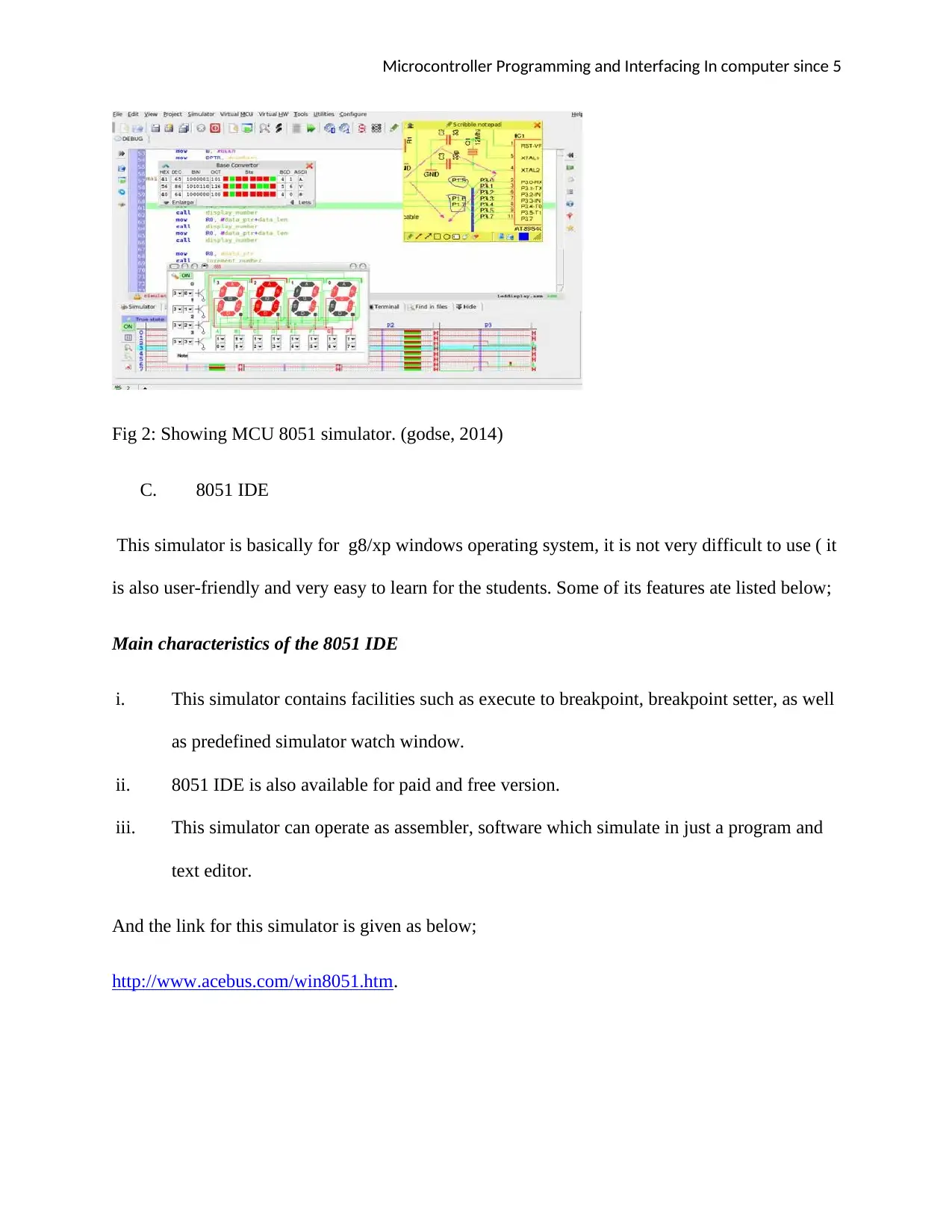
Microcontroller Programming and Interfacing In computer since 5
Fig 2: Showing MCU 8051 simulator. (godse, 2014)
C. 8051 IDE
This simulator is basically for g8/xp windows operating system, it is not very difficult to use ( it
is also user-friendly and very easy to learn for the students. Some of its features ate listed below;
Main characteristics of the 8051 IDE
i. This simulator contains facilities such as execute to breakpoint, breakpoint setter, as well
as predefined simulator watch window.
ii. 8051 IDE is also available for paid and free version.
iii. This simulator can operate as assembler, software which simulate in just a program and
text editor.
And the link for this simulator is given as below;
http://www.acebus.com/win8051.htm.
Fig 2: Showing MCU 8051 simulator. (godse, 2014)
C. 8051 IDE
This simulator is basically for g8/xp windows operating system, it is not very difficult to use ( it
is also user-friendly and very easy to learn for the students. Some of its features ate listed below;
Main characteristics of the 8051 IDE
i. This simulator contains facilities such as execute to breakpoint, breakpoint setter, as well
as predefined simulator watch window.
ii. 8051 IDE is also available for paid and free version.
iii. This simulator can operate as assembler, software which simulate in just a program and
text editor.
And the link for this simulator is given as below;
http://www.acebus.com/win8051.htm.
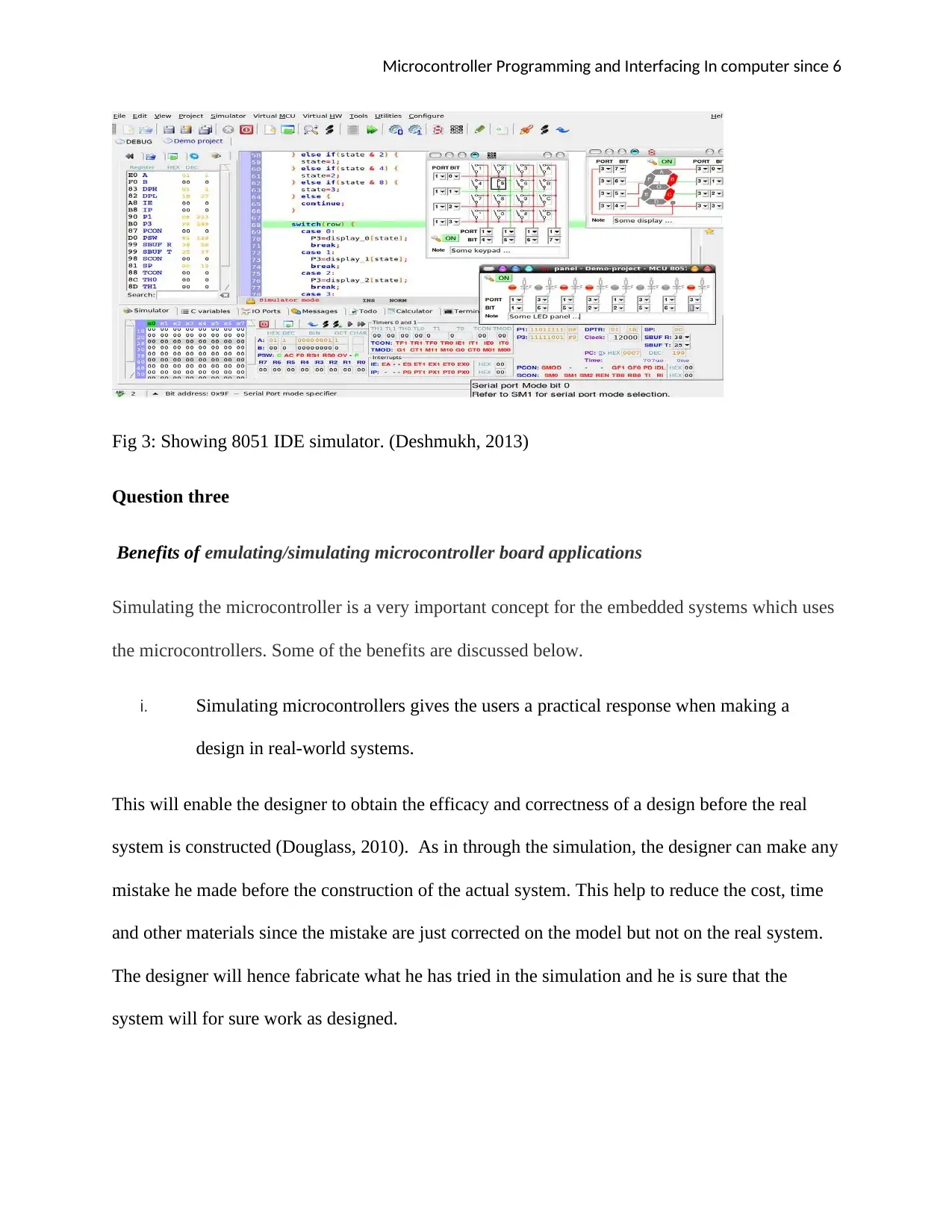
Microcontroller Programming and Interfacing In computer since 6
Fig 3: Showing 8051 IDE simulator. (Deshmukh, 2013)
Question three
Benefits of emulating/simulating microcontroller board applications
Simulating the microcontroller is a very important concept for the embedded systems which uses
the microcontrollers. Some of the benefits are discussed below.
i. Simulating microcontrollers gives the users a practical response when making a
design in real-world systems.
This will enable the designer to obtain the efficacy and correctness of a design before the real
system is constructed (Douglass, 2010). As in through the simulation, the designer can make any
mistake he made before the construction of the actual system. This help to reduce the cost, time
and other materials since the mistake are just corrected on the model but not on the real system.
The designer will hence fabricate what he has tried in the simulation and he is sure that the
system will for sure work as designed.
Fig 3: Showing 8051 IDE simulator. (Deshmukh, 2013)
Question three
Benefits of emulating/simulating microcontroller board applications
Simulating the microcontroller is a very important concept for the embedded systems which uses
the microcontrollers. Some of the benefits are discussed below.
i. Simulating microcontrollers gives the users a practical response when making a
design in real-world systems.
This will enable the designer to obtain the efficacy and correctness of a design before the real
system is constructed (Douglass, 2010). As in through the simulation, the designer can make any
mistake he made before the construction of the actual system. This help to reduce the cost, time
and other materials since the mistake are just corrected on the model but not on the real system.
The designer will hence fabricate what he has tried in the simulation and he is sure that the
system will for sure work as designed.
⊘ This is a preview!⊘
Do you want full access?
Subscribe today to unlock all pages.

Trusted by 1+ million students worldwide

Microcontroller Programming and Interfacing In computer since 7
ii. The simulation also provides the designers of the system with the room to study and
understand the problem at any given level of abstraction.
Through giving the system an approach at a higher level of abstraction, the developer is able to
fathom the interaction and the behavior of the system at a higher level of the component
(Kuhnel, 2012). Thus the designer will be highly equipped to deal with the complicity of the
general system. The complicity may completely overwhelm the designer when the problem is
approached at the lower level.
iii. Simulation is also beneficial in training the student how to simulate the
microcontrollers among other concepts.
This is so easy to enable the student to learn the concept of simulation of the microcontrollers in
their broad applications (Hull, 2012). Through demonstration, the student will learn and know
how the simulation is done. This will provide the student with a better understanding of the
system nature and their operation.
Challenges of emulating/simulating microcontroller board applications.
i. Huma behavior
The behavior of human makes it very challenging for the simulation, this is because in most
simulations codes are employed. These codes are not familiar with human life. The codes are not
just plain English which can be understood by man rather they are machine language which is
very difficult to understand.
ii. Cost
ii. The simulation also provides the designers of the system with the room to study and
understand the problem at any given level of abstraction.
Through giving the system an approach at a higher level of abstraction, the developer is able to
fathom the interaction and the behavior of the system at a higher level of the component
(Kuhnel, 2012). Thus the designer will be highly equipped to deal with the complicity of the
general system. The complicity may completely overwhelm the designer when the problem is
approached at the lower level.
iii. Simulation is also beneficial in training the student how to simulate the
microcontrollers among other concepts.
This is so easy to enable the student to learn the concept of simulation of the microcontrollers in
their broad applications (Hull, 2012). Through demonstration, the student will learn and know
how the simulation is done. This will provide the student with a better understanding of the
system nature and their operation.
Challenges of emulating/simulating microcontroller board applications.
i. Huma behavior
The behavior of human makes it very challenging for the simulation, this is because in most
simulations codes are employed. These codes are not familiar with human life. The codes are not
just plain English which can be understood by man rather they are machine language which is
very difficult to understand.
ii. Cost
Paraphrase This Document
Need a fresh take? Get an instant paraphrase of this document with our AI Paraphraser
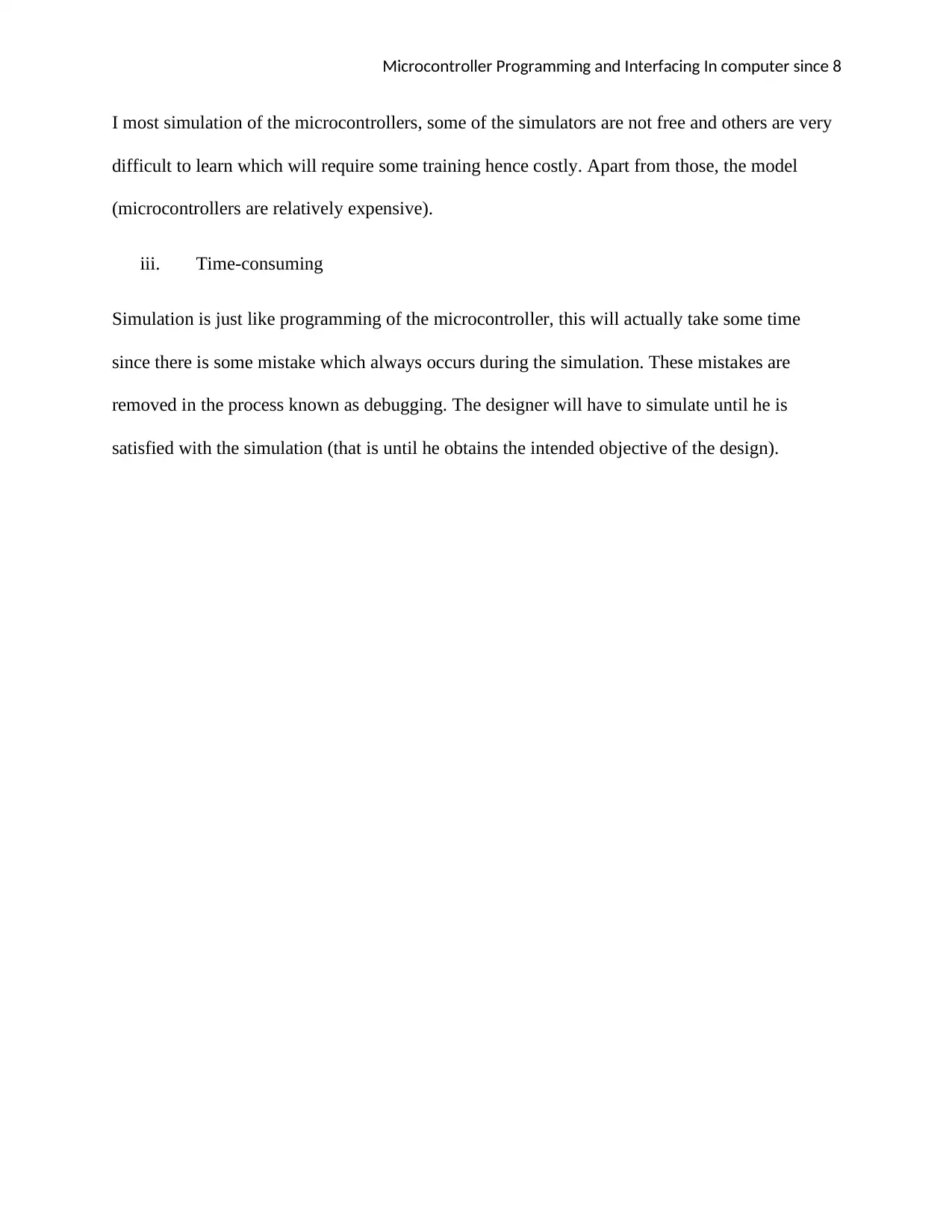
Microcontroller Programming and Interfacing In computer since 8
I most simulation of the microcontrollers, some of the simulators are not free and others are very
difficult to learn which will require some training hence costly. Apart from those, the model
(microcontrollers are relatively expensive).
iii. Time-consuming
Simulation is just like programming of the microcontroller, this will actually take some time
since there is some mistake which always occurs during the simulation. These mistakes are
removed in the process known as debugging. The designer will have to simulate until he is
satisfied with the simulation (that is until he obtains the intended objective of the design).
I most simulation of the microcontrollers, some of the simulators are not free and others are very
difficult to learn which will require some training hence costly. Apart from those, the model
(microcontrollers are relatively expensive).
iii. Time-consuming
Simulation is just like programming of the microcontroller, this will actually take some time
since there is some mistake which always occurs during the simulation. These mistakes are
removed in the process known as debugging. The designer will have to simulate until he is
satisfied with the simulation (that is until he obtains the intended objective of the design).
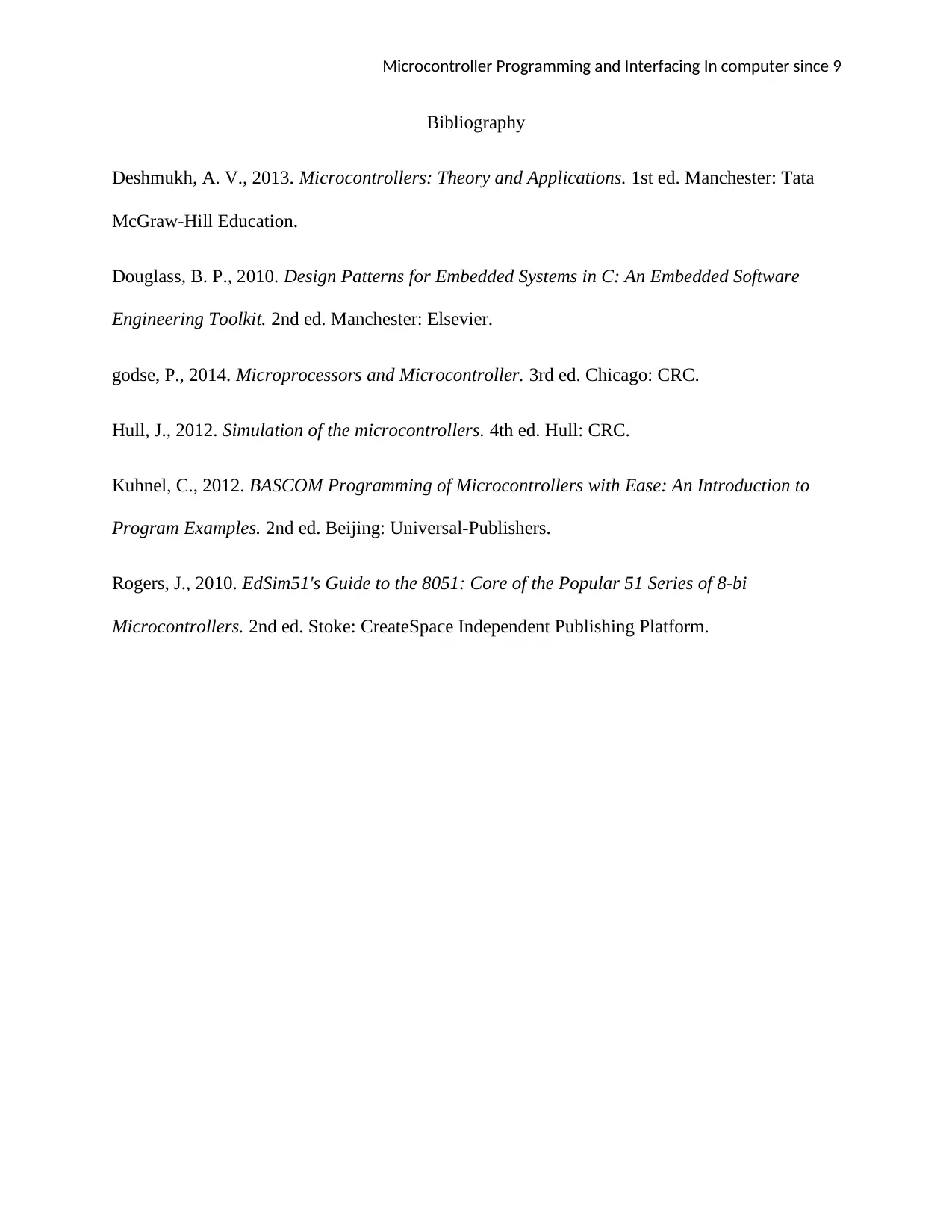
Microcontroller Programming and Interfacing In computer since 9
Bibliography
Deshmukh, A. V., 2013. Microcontrollers: Theory and Applications. 1st ed. Manchester: Tata
McGraw-Hill Education.
Douglass, B. P., 2010. Design Patterns for Embedded Systems in C: An Embedded Software
Engineering Toolkit. 2nd ed. Manchester: Elsevier.
godse, P., 2014. Microprocessors and Microcontroller. 3rd ed. Chicago: CRC.
Hull, J., 2012. Simulation of the microcontrollers. 4th ed. Hull: CRC.
Kuhnel, C., 2012. BASCOM Programming of Microcontrollers with Ease: An Introduction to
Program Examples. 2nd ed. Beijing: Universal-Publishers.
Rogers, J., 2010. EdSim51's Guide to the 8051: Core of the Popular 51 Series of 8-bi
Microcontrollers. 2nd ed. Stoke: CreateSpace Independent Publishing Platform.
Bibliography
Deshmukh, A. V., 2013. Microcontrollers: Theory and Applications. 1st ed. Manchester: Tata
McGraw-Hill Education.
Douglass, B. P., 2010. Design Patterns for Embedded Systems in C: An Embedded Software
Engineering Toolkit. 2nd ed. Manchester: Elsevier.
godse, P., 2014. Microprocessors and Microcontroller. 3rd ed. Chicago: CRC.
Hull, J., 2012. Simulation of the microcontrollers. 4th ed. Hull: CRC.
Kuhnel, C., 2012. BASCOM Programming of Microcontrollers with Ease: An Introduction to
Program Examples. 2nd ed. Beijing: Universal-Publishers.
Rogers, J., 2010. EdSim51's Guide to the 8051: Core of the Popular 51 Series of 8-bi
Microcontrollers. 2nd ed. Stoke: CreateSpace Independent Publishing Platform.
⊘ This is a preview!⊘
Do you want full access?
Subscribe today to unlock all pages.

Trusted by 1+ million students worldwide
1 out of 9
Your All-in-One AI-Powered Toolkit for Academic Success.
+13062052269
info@desklib.com
Available 24*7 on WhatsApp / Email
![[object Object]](/_next/static/media/star-bottom.7253800d.svg)
Unlock your academic potential
Copyright © 2020–2025 A2Z Services. All Rights Reserved. Developed and managed by ZUCOL.
